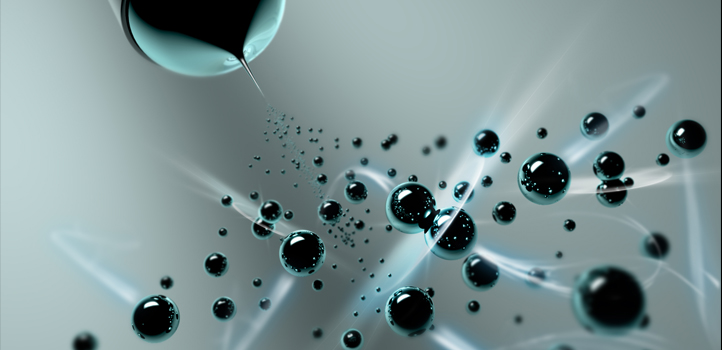Environmental Science and Engineering
Probing water’s skin
Electrosprays of water cannot reliably probe the air-water interface.


Himanshu Mishra (left), Adriano Sanchez (center) and Adair Gallo examine an oil-water system.
© 2019 KAUST
From the wind-whipped surface of the open ocean to trillions of tiny water drops in clouds, the air-water interface—water’s skin—is the site for crucial natural processes, including ocean-atmosphere exchange and cloud acidification. The air-water interface has even been postulated as the cradle of life. However, factors, such as its subnanometer size and dynamic nature, render the investigation of interfacial water a daunting task.
In recent years, researchers have investigated the air-water interface using electrosprays of water: fine sprays produced by applying greater than 5000 V to water solutions passing through a metallic capillary. Traditionally, electrosprays have been used to study ions in the gas phase. Using electrosprays, researchers have suggested that the surface of mildly acidic water behaves as a highly reactive superacid. But the debate remains whether the air-water interface at mild pH can really behave as a superacid.
Now, KAUST researchers led by Himanshu Mishra have employed complementary techniques to disentangle purely interfacial effects from electrospray-specific effects.
Researchers at KAUST are revealing new discoveries at the air-water interface.
© 2019 KAUST
The researchers investigated the reactivity of isoprene—a volatile molecule released by plants experiencing heat stress—at the water interface. “We compared two scenarios: electrosprays of water interacting with isoprene gas and vigorously stirred mixtures of water and isoprene in closed vials,” explains Adair Gallo Jr., a Ph.D. student in Mishra’s team and lead author of the study.
The team looked for the formation of short isoprene chains called oligomers. “Intriguingly, isoprene spontaneously formed oligomers in electrosprays under acidic and basic conditions, and even in the absence of water,” Gallo says. No oligomerization products were detected when acidified water was vigorously stirred with isoprene for hours. But when the same organic phase was electrosprayed, oligomers formed. The findings unequivocally establish that the oligomerization took place exclusively in electrosprays.

Electrospray ionization can produce tiny highly charged and acidic droplets that catalyze chemical reactions in the gas phase.
© KAUST; Ivan Gromicho
Computer simulations carried out by Adriano Sanchez, a postdoc in Mishra’s team, gave molecular-scale insights into the results. “We found that oligomer formation was only possible on gas-phase clusters comprising not more than three water molecules and an excess proton,” Sanchez says.
Collectively, the team’s results demonstrated that electrosprays present highly energetic gas-phase pathways for chemical reactions to occur that are impossible at natural air-water interfaces. “Electrosprays should therefore be complemented with surface-specific techniques and computer simulations to avoid incorrect conclusions when studying interfacial processes,” Mishra says. “I have been thinking about this problem for over six years, and now, thanks to my team, we have managed to disentangle purely interfacial effects from artifacts” says Mishra. This contribution will feature on the cover of the journal Chemical Science.

Members of the KAUST team from left to right: Himanshu Mishra, Adriano Sanchez, Adair Gallo and Andreia Farinha.
© 2019 KAUST
References
-
Gallo Jr, A., Farinha, A. S. F., Dinis, M., Emwas, A.-H. Santana, A., Neilsen, R.J., Goddard, W.A. & Mishra, H. The chemical reactions in electrosprays of water do not always correspond to those at the pristine air– water interface. Chemical Science 10, 2566-2577 (2019).| article
You might also like

Environmental Science and Engineering
Combat climate change by eliminating easy targets

Environmental Science and Engineering
Wastewater treatment to fight the spread of antibiotic resistance

Bioscience
Digging into the world of plant-growth-promoting microbes

Bioscience
Unique microbiome discovered in mountain streams

Chemical Engineering
Unveiling the role of biomass-burning aerosols in atmospheric reactions

Chemical Engineering
Precision separations with perfect pores

Environmental Science and Engineering
Practical support for building sustainability into our cities

Environmental Science and Engineering




